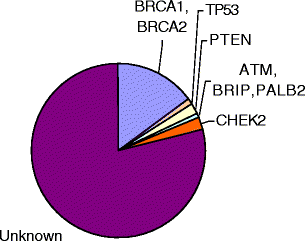Pathology of hereditary breast cancer
- PMID: 21336636
- PMCID: PMC3063560
- DOI: 10.1007/s13402-011-0010-3
Pathology of hereditary breast cancer
Abstract
Background: Hereditary breast cancer runs in families where several members in different generations are affected. Most of these breast cancers are caused by mutations in the high penetrance genes BRCA1 and BRCA2 accounting for about 5% of all breast cancers. Other genes that include CHEK2, PTEN, TP53, ATM, STK11/LKB1, CDH1, NBS1, RAD50, BRIP1 and PALB2 have been described to be high or moderate penetrance breast cancer susceptibility genes, all contributing to the hereditary breast cancer spectrum. However, in still a part of familial hereditary breast cancers no relationship to any of these breast cancer susceptibility genes can be found. Research on new susceptibility genes is therefore ongoing.
Design: In this review we will describe the function of the today known high or moderate penetrance breast cancer susceptibility genes and the consequences of their mutated status. Furthermore, we will focus on the histology, the immunophenotype and genotype of breast cancers caused by mutations in BRCA1 and BRCA2 genes and the other high or moderate penetrance breast cancer susceptibility genes. Finally, an overview of the clinical implications of hereditary breast cancer patients will be provided.
Conclusion: This information leads to a better understanding of the morphological, immunohistochemical and molecular characteristics of different types of hereditary breast cancers. Further, these characteristics offer clues for diagnosis and new therapeutic approaches.
Figures


References
-
- Pathology of familial breast cancer: differences between breast cancers in carriers of BRCA1 or BRCA2 mutations and sporadic cases. Breast Cancer Linkage Consortium. Lancet 349, 1505–1510 (1997) - PubMed
-
- Adem C, Soderberg CL, Hafner K, Reynolds C, Slezak JM, Sinclair CS, Sellers TA, Schaid DJ, Couch F, Hartmann LC, Jenkins RB. ERBB2, TBX2, RPS6KB1, and MYC alterations in breast tissues of BRCA1 and BRCA2 mutation carriers. Genes Chromosom. Cancer. 2004;41:1–11. - PubMed
-
- Agnarsson BA, Jonasson JG, Bjornsdottir IB, Barkardottir RB, Egilsson V, Sigurdsson H. Inherited BRCA2 mutation associated with high grade breast cancer. Breast Cancer Res. Treat. 1998;47:121–127. - PubMed
Publication types
MeSH terms
Substances
LinkOut - more resources
Full Text Sources
Other Literature Sources
Medical
Research Materials
Miscellaneous

